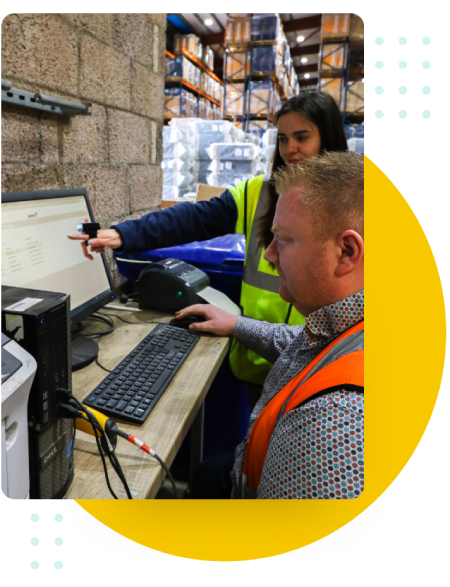What is an Inventory Management Software?
Now that you have a good understanding of what inventory management is, it will be easier to understand what an inventory management software is.
An inventory management software is a tool that helps you organise all the elements of inventory management, and create a centralised experience out of it. Essentially, it can be defined as the process that brings everything together and keeps it that way! Whether it is tracking goods or streamlining the supply chain, an inventory management software will help you be on top of all the important inventory management related processes.
Inventory Management Software Examples
When it comes to inventory management systems, there are many options and solutions available in the market that help you implement inventory optimization. Deciding which one works the best for you requires an insight into what you need as a company. We will get into that later, but generally, there are 3 types of inventory management softwares: manual inventory management software, periodic inventory management software, and perpetual inventory management software.
However, periodic and manual inventory management systems are very similar and hence, can be perceived interchangeably. Hence, we will be focusing only on periodic and perpetual inventory management software’s.
Periodic inventory management softwares are essentially what we can regard as old fashioned inventory. Mainly because periodic inventory management is dependent on taking physical counts of your stock. Implementing a periodic inventory management software basically means that you are counting your stock consistently but at long intervals. It will also conclude by calculating the financial value of this stock.
Perpetual inventory management softwares are systems that help you track your inventory activity as well as other assets across the supply chain in real time. So, this is an automated system that updates every time you make a sale, or lose an item, or deliver something, and hence gives you a wholly accurate account of your stock levels and other relevant factors. Needless to say, a perpetual inventory management software takes priority over a perpetual inventory management software – simply because it is automated and hence offers more convenience.
Some main types of perpetual inventory management softwares include: manual/low tech inventory management, dedicated inventory management software, and integrated retail operations solutions.
Why is Inventory Management Software Important?
Now that we are done with inventory management software examples, let’s look at why such a system is important to begin with. The list of benefits associated with inventory management that we discussed in section 1 can only be achieved by the help of an inventory management software, and that too a perpetual inventory system.
An inventory management software helps you maintain accuracy and make data-based decisions for all aspects of your business. Investing in such a system does not only mean that you are making a good choice for your inventory, but it also means that you can improve all the other elements that go into improving your business.
What’s even better is that an inventory management software can help you streamline multichannel marketing. In the 21st century, it is not uncommon for sellers to expand across different platforms and deal with customers from multiple selling channels. Even if you are not currently interested in this business model, as you grow and upscaling your business becomes a more realistic endeavour for you, you will realise that multichannel selling is a great option.
Yet, the only way you can achieve success on multiple platforms is if you focus on inventory control. If you resort to traditional methods, it is unlikely that you will be able to deal with multichannel inventory management since it involves a plethora of factors that need constant surveillance. However, if you use an inventory management software, it can be pretty easy to manage everything, and that too in considerably less time.
Other than that, since a perpetual inventory management software helps you equip your warehouse and inventory with end-to-end automation, it can also help you minimise some operational inventory management issues such as overstocking, understocking, and knock-on impacts. All of these, if not dealt with on time, can lead to losses. Even worse, these issues can impact your brand reputation and discourage customers from engaging with you on any level. So, warehouse inventory management software. A warehouse inventory management software will help you amalgamate your warehouse with your inventory, and equip both of them with efficiency.
Inventory Management Software: Cloud Based
What is cloud based inventory management software? Essentially, cloud based inventory management refers to the kind of system that is not-device oriented. In saying that, we mean that using a cloud based inventory management system, you can easily access your data remotely as well. Not only that, but cloud based technology also helps you track your inventory in real time, and provides you with instant updates.
With cloud based technology, all it takes for you to manage hundreds of inventory processes is a one-click login. One click, and you have reports, history, and all other records available to access. Surely, this sort of efficiency is something that all businesses yearn for and hence, an integral part of any organisation. The efficiency is also one of the biggest factors that makes cloud based inventory management a better option than manual inventory.
Replace on-premises software with Canary7’s 3PL cloud based software for better, more functional, and efficient warehousing and fulfilment procedures. Unlike traditional on-site warehouse and inventory systems, Canary7 ensures value for money by introducing you to technology and tools that actually work.
Benefits of cloud based inventory management software
Cost-friendly: optimise your budget and save money.
Our inventory management cloud based software is cost-friendly. Not only does our software activate straight out of the box, but you also don’t have to pay for anything other than the charges per individual. In actuality, this is a budget-friendly package, giving a refreshing alternative to the time-consuming and expensive set up of on-premises software.
Save money today, and opt for Canary7’s cloud based inventory management software that are designed specifically to bring productivity to the heart of your fulfilment procedures, without compromising the cost-efficiency of your business.
If you’re looking to increase those profit margins, Canary7’s 3PL cloud based inventory management software is the best possible option.
Data security – keep your data safe forever
Unlike traditional, on-site software, Canary7 is focused on keeping your data safe no matter what happens. In case misfortune strikes, you get to rest assured that your valuable information is forever safe in the Cloud.
For 3PLs, this is a very important factor since it allows you to be answerable to your clients and their customers in a considerably more responsible manner. Build your reputation and prove to your clients that you are capable of tackling not only your challenges and problems, but also theirs.
Using cloud-based technology means that you will always have a back up, so your data on our cloud based inventory management software is not as vulnerable as it would be if you were to rely on an on-site system. So, keep your data safe forever and choose Canary7 as your go to option for all your software solutions.
Easy to Use
Just because an inventory management system is based on cloud technology doesn’t mean it has to be so complicated and technical to understand that you can’t make use of it on a daily basis. In fact, one of the most prominent distinguishing factors of a cloud-based inventory management system is the very fact that it is easier to use, and doesn’t require you to cross miles in order to make sure that you are employing it in a way that actually leads to an effective change to your inventory.
Ideally, a cloud based inventory management system would be quite easy and straightforward to use by you and the rest of your staff. Good inventory management solutions always come equipped with extra help such as user guides which make the other features even more accessible for you whenever you like. If you have a small set up, then look for a cloud based inventory management system for a small business that is not too complicated to understand.
Cloud Based Inventory Management Software Features:



























